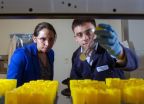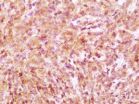(Press-News.org) TAIPEI, TAIWAN--The Phalaenopsis orchid, also known as the moth orchid, is the most important pot flower in terms of market value in the world's major floriculture markets. Because nitrogen significantly affects the growth and flowering of Phalaenopsis, nitrogen needs during flowering are of particular interest to growers. Researchers Hadi Susilo, Ying-Chun Peng, and Yao-Chien Alex Chang from the Department of Horticulture and Landscape Architecture at National Taiwan University published a study in the Journal of the American Society for Horticultural Science that determined the importance of providing Phalaenopsis with ample nitrogen fertilization at the its various growth stages.
"To our knowledge, the relative contributions of stored nitrogen (N) and recently absorbed fertilizer N to the developing inflorescence had not been studied in Phalaenopsis," the authors said. "The relative contributions to the stored N pool of N accumulated during the different growth stages during the long vegetative period of Phalaenopsis cultivation were also unknown. The objective of our study was to bring answers to these unknowns."
The team used N-labeling--a powerful research tool for accurately determining the fate of nitrogen in the environment--to compare the contributions of fertilizer N, applied before or after spiking, to the developing inflorescence, and compared the relative contributions of fertilizer N absorbed during various stages of the vegetative period to the stored N pool. "The nutritional study of Phalaenopsis is difficult with traditional methods because it has a strong buffering capacity against nutrient deficiency, but we used 15N-labeling with the enrichment method to accurately trace the absorption and partitioning of fertilizer N in Phalaenopsis," the scientists said.
The results of multiple experiments showed that inflorescence is a major N sink during the reproductive stage of Phalaenopsis. "Fertilizer applied during the reproductive stage is a significant N source for the inflorescence development of Phalaenopsis, whereby current fertilizer application supplies 57% of the N required for inflorescence development. Therefore, providing sufficient fertilizer N is important during the reproductive stage to ensure the quality of flowering," the authors said.
Further experiments showed that, even when ample fertilization was provided during the reproductive stage, 6-8% of the nitrogen accumulated during growing Stage I (small plant in 4.5-cm pot for 5 months), Stage II (medium plant in 8.5-cm pot for 5 months), and Stage III (large plant in 10.5-cm pot for 5 months) ended up in the inflorescence at the visible bud stage. At the "two-third flowers open" stage, 12-16% of the N accumulated in the plant during these three stages ended up in the inflorescence. The scientists concluded that these results indicated the importance of providing Phalaenopsis with ample N fertilization at all growth stages.
INFORMATION:
The complete study and abstract are available on the ASHS J. Amer. Soc. Hort. Sci. electronic journal web site: http://journal.ashspublications.org/content/139/1/69.abstract
Founded in 1903, the American Society for Horticultural Science (ASHS) is the largest organization dedicated to advancing all facets of horticultural research, education, and application. More information at ashs.org
Nitrogen source determined significant for inflorescence development in Phalaenopsis
Research shows importance of ample nitrogen fertilization at all growth stages
2014-03-26
ELSE PRESS RELEASES FROM THIS DATE:
Engineered bacteria produce biofuel alternative for high-energy rocket fuel
2014-03-26
Researchers at the Georgia Institute of Technology and the Joint BioEnergy Institute have engineered a bacterium to synthesize pinene, a hydrocarbon produced by trees that could potentially replace high-energy fuels, such as JP-10, in missiles and other aerospace applications. With improvements in process efficiency, the biofuel could supplement limited supplies of petroleum-based JP-10, and might also facilitate development of a new generation of more powerful engines.
By inserting enzymes from trees into the bacterium, first author and Georgia Tech graduate student ...
Ancient sea creatures filtered food like modern whales
2014-03-26
The animals lived 520 million years ago during the Early Cambrian, a period known as the 'Cambrian Explosion' in which all the major animal groups and complex ecosystems suddenly appeared. Tamisiocaris belongs to a group of animals called anomalocarids, a type of early arthropod that included the largest and some of the most iconic animals of the Cambrian period. They swam using flaps down either side of the body and had large appendages in front of their mouths that they most likely used to capture larger prey, such as trilobites.
However, the newly discovered fossils ...
First ring system around asteroid
2014-03-26
The rings of Saturn are one of the most spectacular sights in the sky, and less prominent rings have also been found around the other giant planets. Despite many careful searches, no rings had been found around smaller objects orbiting the Sun in the Solar System. Now observations of the distant minor planet [1] (10199) Chariklo [2] as it passed in front of a star have shown that this object too is surrounded by two fine rings.
"We weren't looking for a ring and didn't think small bodies like Chariklo had them at all, so the discovery — and the amazing amountof detail ...
Gut metabolism changes -- not stomach size -- linked to success of vertical sleeve gastrectomy
2014-03-26
CINCINNATI—It's not the size of the stomach that causes weight loss after a specific type of bariatric surgery, but rather a change in the gut metabolism, say researchers from the University of Cincinnati (UC), the University of Gothenburg in Sweden and Cincinnati Children's Hospital Medical Center.
The scientists, publishing their results in the March 26, 2014, advanced online edition of Nature, have found that following vertical sleeve gastrectomy, there is a change in bile acids that bind to a nuclear receptor called FXR. In the absence of FXR, the researchers showed, ...
Some breast cancer tumors hijack patient epigenetic machinery to evade drug therapy
2014-03-26
PITTSBURGH, March 26, 2014 – A breast cancer therapy that blocks estrogen synthesis to activate cancer-killing genes sometimes loses its effectiveness because the cancer takes over epigenetic mechanisms, including permanent DNA modifications in the patient's tumor, once again allowing tumor growth, according to an international team headed by the University of Pittsburgh Cancer Institute (UPCI).
The finding warrants research into adding drugs that could prevent the cancer from hijacking patients' repressive gene regulatory machinery, which might allow the original therapy ...
First comprehensive atlas of human gene activity released
2014-03-26
Boston, MA — A large international consortium of researchers has produced the first comprehensive, detailed map of the way genes work across the major cells and tissues of the human body. The findings describe the complex networks that govern gene activity, and the new information could play a crucial role in identifying the genes involved with disease.
"Now, for the first time, we are able to pinpoint the regions of the genome that can be active in a disease and in normal activity, whether it's in a brain cell, the skin, in blood stem cells or in hair follicles," said ...
Brain degeneration in Huntington's disease caused by amino acid deficiency
2014-03-26
Working with genetically engineered mice, Johns Hopkins neuroscientists report they have identified what they believe is the cause of the vast disintegration of a part of the brain called the corpus striatum in rodents and people with Huntington's disease: loss of the ability to make the amino acid cysteine. They also found that disease progression slowed in mice that were fed a diet rich in cysteine, which is found in foods such as wheat germ and whey protein.
Their results suggest further investigation into cysteine supplementation as a candidate therapeutic in people ...
Cosmic collision creates mini-planet with rings
2014-03-26
Until now, rings of material in a disc have only been observed around giant planets like Jupiter, Uranus, Neptune and especially Saturn, which is known for its spectacular rings. Now astronomers from the Niels Bohr Institute, among others, have observed the first miniature planet with two rings of ice and pebbles. It is a smaller celestial body, called Chariklo, located two billion kilometers out in the solar system between Saturn and Uranus. The results are published in the prestigious scientific journal, Nature.
Chariklo was located in the Kuiper Belt, a collection ...
New maps for navigating the genome unveiled by scientists
2014-03-26
Scientists have built the clearest picture yet of how our genetic material is regulated in order to make the human body work.
They have mapped how a network of switches, built into our DNA, controls where and when our genes are turned on and off.
University of Edinburgh scientists played a leading role in the international project – called FANTOM5 – which has been examining how our genome holds the code for creating the fantastic diversity of cell types that make up a human.
The three year project, steered by the RIKEN Center for Life Science Technologies in Japan, ...
Keeping secrets in a world of spies and mistrust
2014-03-26
VIDEO:
This is an interview with Professor Artur Ekert, co-inventor of quantum cryptography, about what it takes to keep secrets secret.
Click here for more information.
Revelations of the extent of government surveillance have thrown a spotlight on the security – or lack thereof – of our digital communications. Even today's encrypted data is vulnerable to technological progress. What privacy is ultimately possible? In the 27 March issue of Nature, the weekly international ...
LAST 30 PRESS RELEASES:
Experiments advance potential of protein that makes hydrogen sulfide as a therapeutic target for Alzheimer’s disease
Examining private equity’s role in fertility care
Current Molecular Pharmacology achieves a landmark: real-time CiteScore advances to 7.2
Skeletal muscle epigenetic clocks developed using postmortem tissue from an Asian population
Estimating unemployment rates with social media data
Climate policies can backfire by eroding “green” values, study finds
Too much screen time too soon? A*STAR study links infant screen exposure to brain changes and teen anxiety
Global psychiatry mourns Professor Dan Stein, visionary who transformed mental health science across Africa and beyond
KIST develops eco-friendly palladium recovery technology to safeguard resource security
Statins significantly reduce mortality risk for adults with diabetes, regardless of cardiovascular risk
Brain immune cells may drive more damage in females than males with Alzheimer’s
Evidence-based recommendations empower clinicians to manage epilepsy in pregnancy
Fungus turns bark beetles’ defenses against them
There are new antivirals being tested for herpesviruses. Scientists now know how they work
CDI scientist, colleagues author review of global burden of fungus Candida auris
How does stroke influence speech comprehension?
B cells transiently unlock their plasticity, risking lymphoma development
Advanced AI dodel predicts spoken language outcomes in deaf children after cochlear implants
Multimodal imaging-based cerebral blood flow prediction model development in simulated microgravity
Accelerated streaming subgraph matching framework is faster, more robust, and scalable
Gestational diabetes rose every year in the US since 2016
OHSU researchers find breast cancer drug boosts leukemia treatment
Fear and medical misinformation regarding risk of progression or recurrence among patients with breast cancer
Glucagonlike peptide-1 receptor agonists and asthma risk in adolescents with obesity
Reviving dormant immunity: Millimeter waves reprogram the immunosuppressive microenvironment to potentiate immunotherapy without obvious side effects
Safety decision-making for autonomous vehicles integrating passenger physiological states by fNIRS
Fires could emit more air pollution than previously estimated
A new way to map how cells choose their fate
Numbers in our sights affect how we perceive space
SIMJ announces global collaborative book project in commemoration of its 75th anniversary
[Press-News.org] Nitrogen source determined significant for inflorescence development in PhalaenopsisResearch shows importance of ample nitrogen fertilization at all growth stages





